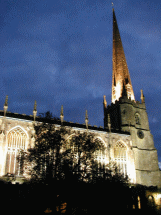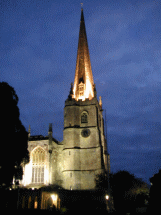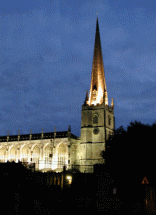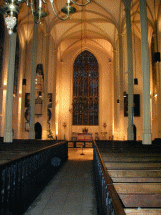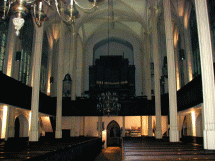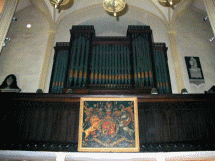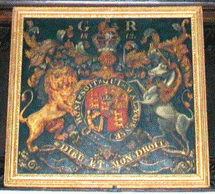|


St Mary the Virgin
|
|
|
|
|
|
|
|
|
Three views of the
floodlit church, taken in the early evening. The tower with its beautiful
slender spire is 186 ft high (57m)., and the fourth highest in the country.
This is all that remains of the old church which stood on the same
spot.
Dove's reference for the bells:
Tetbury, Glos, S Mary, 8, 16¾cwt
in Eflat. Fri. ST891929 |
|
|
|
|
From Father John Hawthorne's introduction to the
church guide:
|
|
"It [the Parish Church of St Mary the
Virgin, Tetbury] is the oldest site of Christian worship in Gloucestershire -
worshippers have been praising God here since 681 - and the present building is
the only Georgian church in the county"
As you can see, it is an
extraordinary building, with its tall slender columns, shallow Sanctuary, high
box pews (with which parishioners enjoy a love-hate relationship) and
ambulatories, or passages, round it. With its enormous windows it has been
described as being "like a lantern".
It was built in the
tradition of preaching, or auditory, churches, at a time when pulpit and
reading desk dominated and the altar took second place. But for the last fifty
years the Holy Eucharist has been at the centre of our worship, and the Church
is now ordered to reflect that. So in re-ordering it in 1992/93 we were able,
also, to rid the Church of many of its Victorian accretions and, so far as was
compatible with the demands of flexibility, restore its interior lines to the
Georgian original in terms of clarity and light."
|
|
This was written in April
1998
|
|
|
|
|
|
|
|
|
Looking towards the
Sanctuary and Altar, taken in the evening and lit only by the church lighting.
Note the box pews, dating from the late eighteenth century. |
|
|
|
|
There is a gallery not only at the west end of the church, but
also continuations of it on both north and south walls. Note the chandelier,
one of two - each with 36 candles - which date from c. 1781.
|
|
|
|
Prior to the building of this church, townspeople
worshipped in a mediaeval church on the same site.
This old church is
recorded as being of complicated plan, with three aisles and three chancels,
various chantries and chapels, and a room over the south porch which housed the
grammar school. Sadly it fell into decay, with disputes in the fifteenth
century about who was responsible for the repair of certain parts of the
building. In 1662 there is a report that the church was shaken by a great
tempest, and by the beginning of the eighteenth century the church was in such
a state that the then incumbent wrote to the Chancellor that the church was
open to the wind almost on every side.
Following an Act of Parliament in
1765 allowing for the church to be completely rebuilt, eventually, in 1777, the
church was demolished, apart from its tower and spire, which were judged to be
safe.
The new church was built under the supervision of its architect,
Francis Hiorne of Warwick, and was completed in 1781 at a total cost of
£5,059. 12s. 0d.
|
|
|
|
|
|
|
The Nave area is completely filled by the original,
high, box pews of dark oak, which are most uncommon. . . . Some of the pews
have been 'customised' by their previous regular users,in the past, with a
prayer book drawer under th seat, a lock on the door, or extra depth added to
the seat. A great deal of self discipline must have been exercised by church
goers of the old 'preaching church' days, when they would have
t o sit in the not
too comfortable pews through extremely long sermons. There would be no escape
in slumping down in the seat, as the original high canopied pulpit,
(unfortunately lost in earlier changes to the church) gave good visibility all
round.
Old wooden rails, rescued from the Vicarage stables, separate the
Sanctuary, which is raised a few steps above the remainder of the
interior.
Dominating the west end of the church is the large gallery,
fronted with dark panelling, and accessed by a staircase at each corner. (For
safety reasons the gallery is not normally open to the public). The organ
occupies a purpose built recess here, and the choir sits in front. Soon after
the church was opened, more seating wa needed, so forward extensions, fitted
with box pews of normal height, were installed.
The arms of George III
hang on the front of the gallery.
|
|
|
|
|
|
|
The vicissitudes of the Victoran
reformers have all but been removed by the most recent of restorations in
1992/93. The organ had, in 1901, been removed from the gallery and placed upon
high posts in front of the window in the first bay of the south side of the
Chancel, new choir stalls were placed on a three foot high podium within the
chancel (taking up about half its width), and the Sanctuary raised to suit. in
1917 a screen was also added at its western edge. The alteratins were
subsequently described by a former vicar, Canon Michael Sherwood, as
'musically, æsthetically and liturgically unfortunate', something
of an understatement.
|
The above extracts have been taken from various parts of the
church guide, and acknowledgements are given to G Twigg, J K Bullock, G A
Harvey, P Adkins and P Panton, its authors. Photographs © E M L
Macadam, 2001.
|
|
|
|
ACCESS |
|
Map reference : ST891929. The
church is adjacent the A433 road to Chipping Sodbury on the south-west side of
the town. Parking can be a problem as all the surrounding streets are narrow
and what little parking there is, is quickly filled. The church was open at the
time of our visit (30/10/2001), with a volunteer acting
as "church-sitter".
|
|
|
|
Please see our
Home Page
for important copyright notice
|
|
|
|

|
|

|
|
|
|

|
|
the
Webmasters
|
|
|
|
This
site has been constructed by, and remains the
copyright of its authors,
Edwin Macadam and Sheila
Girling Smith, Shelwin, 30, Eynsham Road,
Botley,
Oxford OX2 9BP
|
|
|
|
©
July 2001 -
|
|
email
|
|


